Integration of NDT to Assess Composite Contemporary Artworks Made on Photosensitized Cement
Abstract
:1. Introduction
2. Materials and Methods
2.1. Description of the Artworks
2.2. Non-Invasive Imaging Techniques
2.2.1. Visible Light (VIS)
2.2.2. UV-Induced Visible Fluorescence Imaging (UVF Imaging)
2.2.3. Optical Portable Microscopy
2.2.4. Colorimetry
2.2.5. Infrared Thermography
2.2.6. Raman and SEM-EDX
3. Results and Discussion
3.1. Visible Light Imaging
3.2. Ultraviolet Induced Visual Fluorescence Imaging
3.3. Digital Optical Microscopy
3.4. Colorimetry
3.5. Infrared Thermography Examination
3.6. SEM-EDX and Micro-Raman
4. Conclusions
Author Contributions
Funding
Institutional Review Board Statement
Informed Consent Statement
Data Availability Statement
Conflicts of Interest
References
- Adriaens, A. Non-destructive analysis and testing of museum objects: An overview of 5 years of research within COST Action G8. In Proceedings of the International Symposium on Cultural Heritage Conservation: Non-Destructive Testing Technology Application, Jerusalem, Israel, 25–30 May 2008; p. 24. [Google Scholar]
- Ferretti, M. Scientific Investigation of Works of Art; ICCROM: Rome, Italy, 1993; p. 92. [Google Scholar]
- Gavrilov, D.; Maev, R.G.; Almond, D.P. A review of imaging methods in analysis of works of art: Thermographic imaging methods in art analysis. Can. J. Phys. 2013, 92, 341–364. [Google Scholar] [CrossRef]
- Maev, R.; Gavrilov, D. Thermography in Analysis of Works of Art: Choice of the Optimal Approach. In Proceedings of the 3th International Symposium on Nondestructive Characterization of Materials, (NDCM-XIII), Le Mans, France, 20–24 May 2013; Curran Associates, Inc.: Red Hook, NY, USA, 2013; p. 409. [Google Scholar]
- Brunetti, B.; Miliani, C.; Rosi, F.; Doherty, B. Non-Invasive Investigations of Paintings by Portable Instrumentation: The MOLAB Experience; Topics in Current Chemistry Collections; Springer: Cham, Switzerland, 2016; p. 10. [Google Scholar] [CrossRef]
- Seymour, K. Standard non-destructive techniques used to document and examine artworks employed within the conservation field. In Proceedings of the International Symposium on Cultural Heritage Conservation: Non-Destructive Testing Technology Application, Taiwan, China, 6–7 December 2010; p. 24. [Google Scholar]
- Stratis, J.; Lazidou, D.; Gomez-Sanchez, E. Enhancing the examination workflow for Byzantine icons: Implementation of information technology tools in a traditional context. J. Cult. Herit. 2014, 15, 85–91. [Google Scholar] [CrossRef]
- Carrero, J.A.; Fernandez, L.A.; Gomez, L.; Gomez, N. Non-Destructive and Microanalytical Techniques. In Proceedings of the TECHNART, Bilbao, Spain, 2–6 May 2017; p. 440. [Google Scholar]
- Ranjeetkumar, G.; Daniel, M.; Jamie, B.; Harper, S.; Wenshuo, T.; Pancholi, K.; Baines, L.; Bucknall, D.G.; Flynn, D. A Review of Sensing Technologies for Non-Destructive Evaluation of Structural Composite Materials. J. Compos. Sci. 2021, 5, 319. [Google Scholar] [CrossRef]
- Ricca, M.; Alberghina, M.F.; Randazzo, L.; Schiavone, S.; Donato, A.; Albanese, M.P.; La Russa, M.F. A Combined Non-Destructive and Micro-Destructive Approach to Solving the Forensic Problems in the Field of Cultural Heritage: Two Case Studies. Appl. Sci. 2021, 11, 6951. [Google Scholar] [CrossRef]
- Bas, G.; Haase, G.; Zorgiebel, F. Some SEM Studies on Photographic Emulsions. Scanning 1983, 5, 84–90. [Google Scholar]
- Restany, P. La Mec-art: Una pitura meccanica alla ricerca d’una iconografia moderna. Essere 1968, 4, 14. [Google Scholar]
- Tsigou, E.; Kessanlis, N. The return of the Barbarian. Art Mag. 1995, 19, 40–46. [Google Scholar]
- Tzirtzilakis, Y. (Ed.) Nikos Kessanlis. Macedonian Museum of Modern Art; Adam: Thessaloniki, Greece, 1997; p. 228. [Google Scholar]
- Ross, D. The Handmade Silver Gelatin Emulsion Print; Routledge: New York, NY, USA, 2019; p. 303. [Google Scholar]
- Tackett, K. Alternative Photography. Printing in Objects. Available online: www.instructables.com (accessed on 15 June 2022).
- James, C. The Book of the Alternative Photographic Process; Delmar: Lachine, QC, Canada, 2012; p. 640. [Google Scholar]
- Wall, E.J. Photographic Emulsions; American Photographic Publishing Company: Boston, MA, USA, 1929; p. 280. [Google Scholar]
- Reed, M.; Jones, S. Silver Gelatin: A User’s Guide to Liquid Photographic Emulsions; Argentum: London, UK, 2001; p. 144. [Google Scholar]
- Zelikman, V.L.; Levi, S.M. Making and Coating Photographic Emulsions; Focal Press: London, UK, 1965; p. 312. [Google Scholar]
- Rockland Colloid LLC. Rockland Photographic Emulsions, Liquid Light and Ag-Plus Instructions. Available online: www.rockaloid.com (accessed on 28 September 2023).
- Arapinis, P. Reformations, Photosensitized Cement; AD Gallery: Athens, Greece, 1996; p. 4. [Google Scholar]
- Stamatopoulou, E.; Karoglou, M.; Bakolas, A. Contemporary artworks created on photosensitized cements: Materials and conservation state of Nikos Kessanlis “Wall-Erotica”. J. Cult. Herit. 2019, 41, 43–50. [Google Scholar] [CrossRef]
- Dyer, J.; Sotiropoulou, S. A technical step forward in the integration of visible-induced luminescence imaging methods for the study of ancient polychromy. Her. Sci. 2017, 5, 24. [Google Scholar] [CrossRef]
- Bracci, S.; Iannaccone, R.; Magrini, D. The Application of Multi-Band Imaging Integrated with Non-Invasive Spot Analyses 516 for the Examination of Archaeological Stone Artefacts. In UV-Vis LUMINESCENCE Imaging Techniques. 360 Conservation; Picollo, M., Stols-Witlox, M., Fuster-López, L., Eds.; Universitat Polytechnica de Valencia: Valencia, Spain, 2019; p. 151. [Google Scholar]
- Dyer, J.; Verri, G.; Cupitt, J. Multispectral Imaging in Reflectance and Photo-Induced Luminescence Modes: A User Manual; The British Museum: London, UK, 2013; p. 184. [Google Scholar]
- EN15886; Conservation of Cultural Property-Test Methods-Colour Measurement of Surfaces. European Committee for Standardization: Brussels, Belgium, 2010.
- Jonston-Feller, R. Color Science in Examination of Museum Objects; The Getty Conservation Institute: Los Angeles, CA, USA, 2001; p. 386. [Google Scholar]
- ISO 11664-4:2008(E)/CIE S 014-4 E:2007; Joint ISO/CIE Standard: CIE Colorimetry—Part 4: 1976 L*a*b* Colour Space. International Organization for Standardization, Vernier: Geneva, Switzerland, 2007.
- Nasau, K. (Ed.) Color for Science, Art and Technology; Elsevier: Amsterdam, The Netherlands, 1988; p. 511. [Google Scholar]
- Mitchell, D. Big Differences in UV Tubes, in UV Waves; Newsletter of the Fluorescent; Mineral Society, Inc.: Sacramento, CA, USA, 1996. [Google Scholar]
- Buzit Tragni, C. The Use of Ultraviolet Induced Visible Fluorescence for Examination of Photographs; Andrew, W., Ed.; Mellon Advanced Residency Program in Photograph Conservation; Georges Eastman House & Image Permanence Institute: Rochester, NY, USA, 2005; p. 36. [Google Scholar]
- Messier, P.; Bass, V.; Tafilowski, D.; Varga, L. Optical brightening agents in photographic paper. J. Am. Inst. Conserv. 2005, 44, 1–12. [Google Scholar] [CrossRef]
- Garden, M. Use of Ultraviolet Light as an Aid to Pigment Identification. APT Bull. J. Preserv. Technol. 1991, 23, 26–37. [Google Scholar]
- Measday, D. A Summary of Ultra-Violet Fluorescent Materials Relevant to Conservation. 2021. Available online: https://aiccm.org.au (accessed on 15 March 2021).
- Grys, S. Determining the dimension of subsurface defects by active infrared thermography-experimental research. Copernicus Publications/AMA Association for Sensor Technology. J. Sens. Sens. Syst. 2018, 7, 153–160. [Google Scholar] [CrossRef]
- Boullenois, E. Why Does Concrete Crack? Part 1—The Main Reasons. 2019. Available online: https://blog.master-builders-solutions.com (accessed on 21 March 2019).
- Portland Cement Association. Types and Causes of Concrete Deterioration. 2002. Available online: https://www.cement.org/ (accessed on 15 January 2019).
- Léang, M.; Giorgiutti, F.D.; Lay-Theng, L.; Pauchard, L. Crack opening: From colloidal systems to painting. Soft Matter 2017, 13, 5802–5808. [Google Scholar] [CrossRef] [PubMed]
- Chalhoun, J.M.; Leister, D.A. Effect of Gelatin Layers on the Dimensional Stability of Photographic Film. Photogr. Sci. Eng. 1959, 3, 8–17. [Google Scholar]
- Weaver, G. A Guide to Fiber-Base Gelatin Silver Print Condition and Deterioration; George Eastman House, International Museum of Photography and Film Image Permanence Institute, Rochester Institute of Technology: Rochester, NY, USA, 2008; p. 41. [Google Scholar]
- Rizzieri, R.; Mahadevan, A.; Vaziri, A.; Donald, A. Superficial Wrinkles in Stretched, Drying Gelatin Films. Langmuir 2006, 22, 3622–3626. [Google Scholar] [CrossRef]
- Bernier, B. Issues in Humidification and Drying of Gelatin Silver Prints. Top. Photogr. Preserv. 2005, 11, 6–16. [Google Scholar]
- Kejser, U.B.; Koch, M.S. Degradation of Gelatin in Historical Photographs. Imaging Sci. J. 1997, 45, 260–262. [Google Scholar] [CrossRef]
- Mowrey, R. Photographic Emulsion Making, Coating and Testing. The Handmade Silver Gelatin Emulsion Print; Photographic Systems, LLC: Rochester, NY, USA, 2011; p. 179. [Google Scholar]
- Sanderson, K. Measuring Color Change in Photographs; AIC & ICOM-CC Photographs Conservation: Wellinghton, New Zealand, 2013; p. 178. Available online: https://hclwizard.org/hclcolorpicker (accessed on 13 May 2021).
- Wilhelm, H. Monitoring the fading and staining of color photographic prints. J. Am. Inst. Conserv. 1981, 21, 49–64. [Google Scholar] [CrossRef]
- Ware, M. Mechanisms of Image Deterioration in Early Photographs, Science Museum and National Museum of Photography; Vols. Appendix III, The Colors of Silver Images; Film & Television: London, UK, 1994; pp. 71–76. [Google Scholar]
- Pope, C.I. Formation of Silver Sulfide in the Photographic Image during Fixation; National Bureau of Standards: Washington, DC, USA, 1960; pp. 65–73. [Google Scholar]
- Graedel, J.P.; Franey, G.J.; Gualtieri, G.W.; Kammlott, D.L. On the mechanism of silver and copper sulfidation by atmospheric H2S and OCS. Corr. Sci. 1985, 25, 1163–1180. [Google Scholar] [CrossRef]
- Bagavathiappan, S.; Lahirr, B.; Saravanan, T.; Philip, J.; Jayakumar, T. Infrared thermography for condition monitoring—A review. Infrared Phys. Technol. 2013, 63, 35–55. [Google Scholar] [CrossRef]
- Ammirato, F.; Zayicek, P. Infrared Thermography Field Application Guide; Tech. Rep. TR-107142; Electric Power Research Institute, Inc.: Palo Alto, CA, USA, 1999. [Google Scholar]
- Chrysafi, A.P.; Athanasopoulos, N.; Siakavellas, N.J. Damage detection on composite materials with active thermography. Int. J. Therm. Sci. 2017, 116, 247–253. [Google Scholar] [CrossRef]
- Milovanovic, B.; Pecur, I.B. Review of Active IR Thermography for Detection and Characterization of Defects in Reinforeced Concrete. J. Imaging 2016, 2, 11. [Google Scholar] [CrossRef]
- Suda, K.; Misra, S.; Motobashi, K. Corrosion products of reinforcing bars embedded in concrete. Corr. Sci. 1995, 35, 1651–1656. [Google Scholar] [CrossRef]
- Bertolini, L.; Carsana, M.; Gastaldi, M.; Lollini, F.; Redaelli, E. Corrosion of Steel in Concrete: Prevention, Diagnosis, Repair; John Wiley & Sons: Hoboken, NJ, USA, 2013; p. 434. [Google Scholar]
- Szelag, M. Evaluation of cracking patterns in cement composite-From basics to advances: A review. Materials 2020, 27, 2490. [Google Scholar] [CrossRef]
- Karambinis, L.; Tsironis, A. Conservation Problems of Mixte Media Paintings, Nikos Kessanlis, 1957–1989. Master’s Thesis, Technological and Educational Institute of Athens, Athens, Greece, 1996. [Google Scholar]
- Marucci, G.; Monno, A.; van der Werf, D. Non invasive micro-Raman spectroscopy for investigation of historical silver salt gelatin photographs. Microchem. J. 2014, 117, 220–224. [Google Scholar] [CrossRef]
- Fruschour, B.G.; Koenig, J.L. Raman Scattering of Collagen, Gelatin, and Elastin. Biopolymers 1975, 14, 379–391. [Google Scholar] [CrossRef]
- Coccato, A.; Jehlicka, J.; Moens, L.; Vandenabeele, P. Raman spectroscopy for the investigation of carbon-based black pigments. J. Raman Spectrosc. 2015, 46, 1003–1015. [Google Scholar] [CrossRef]
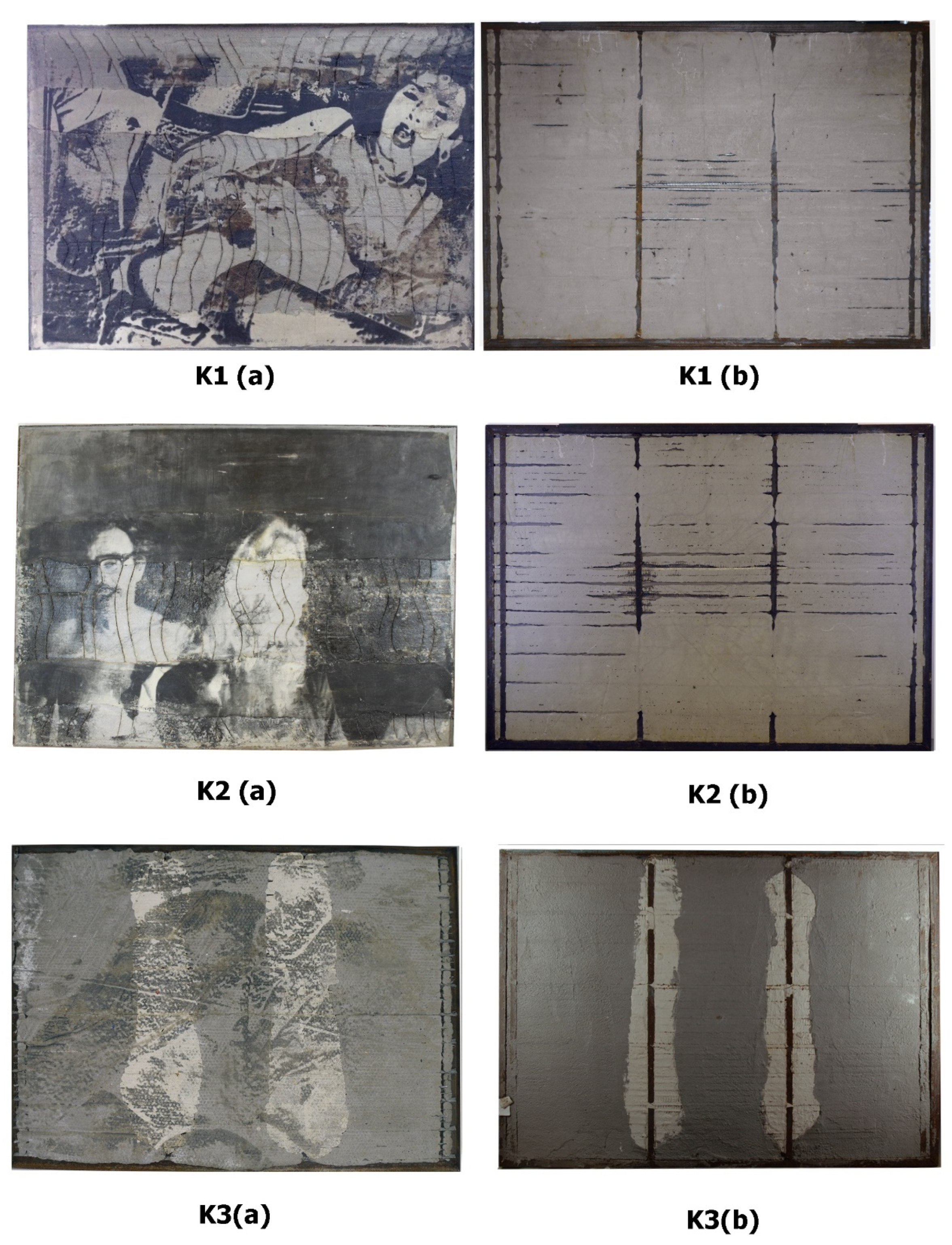
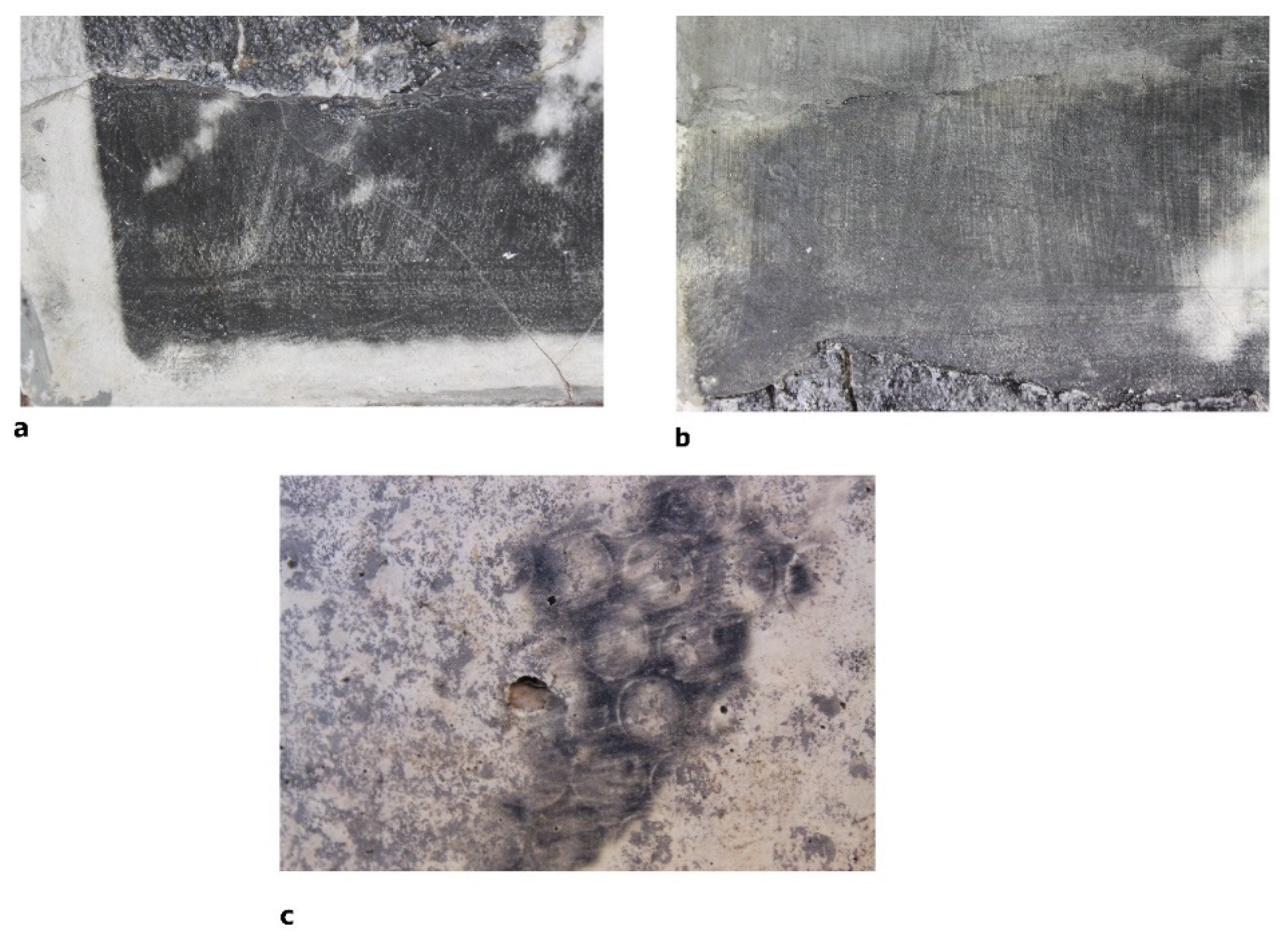

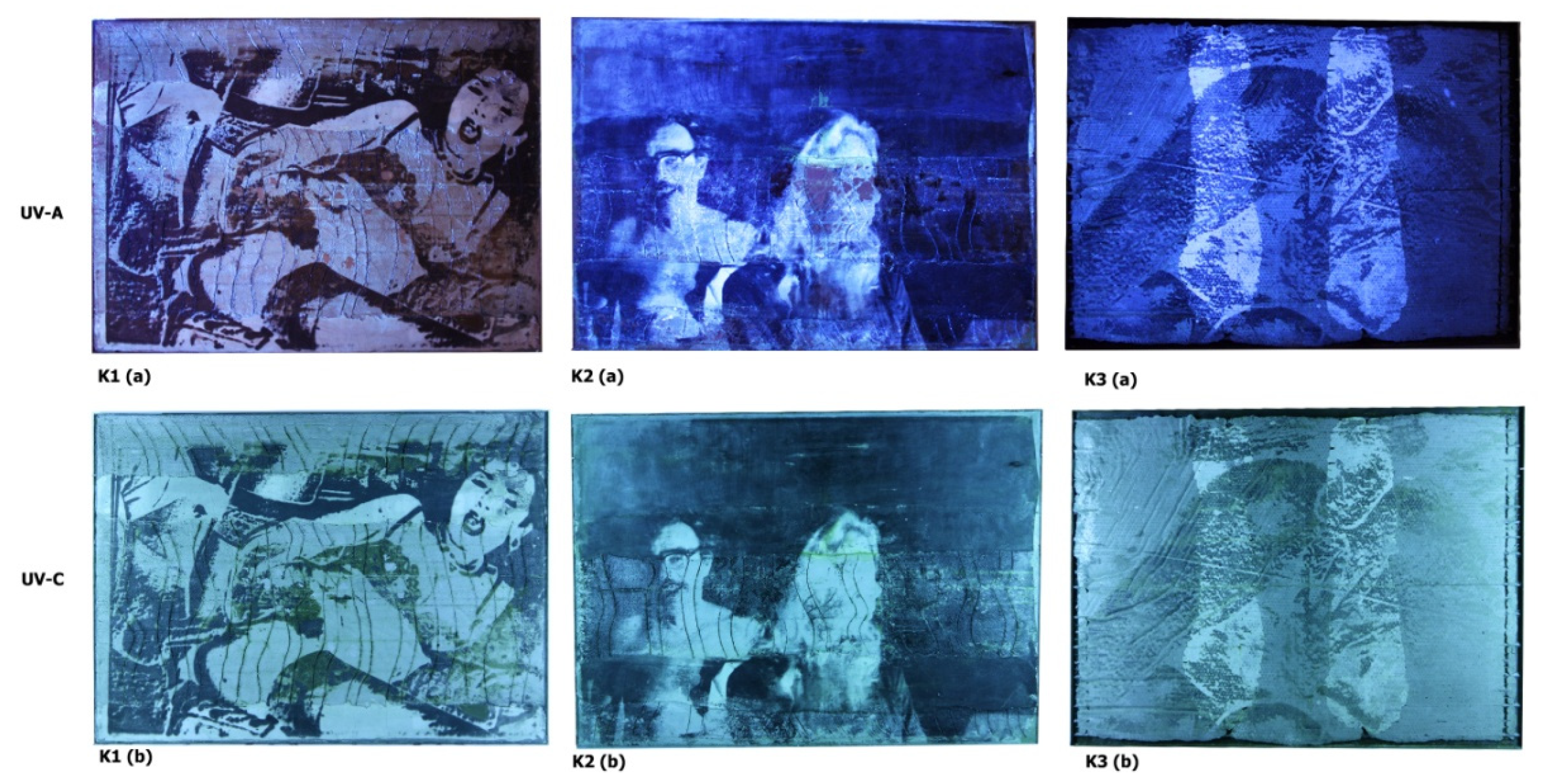
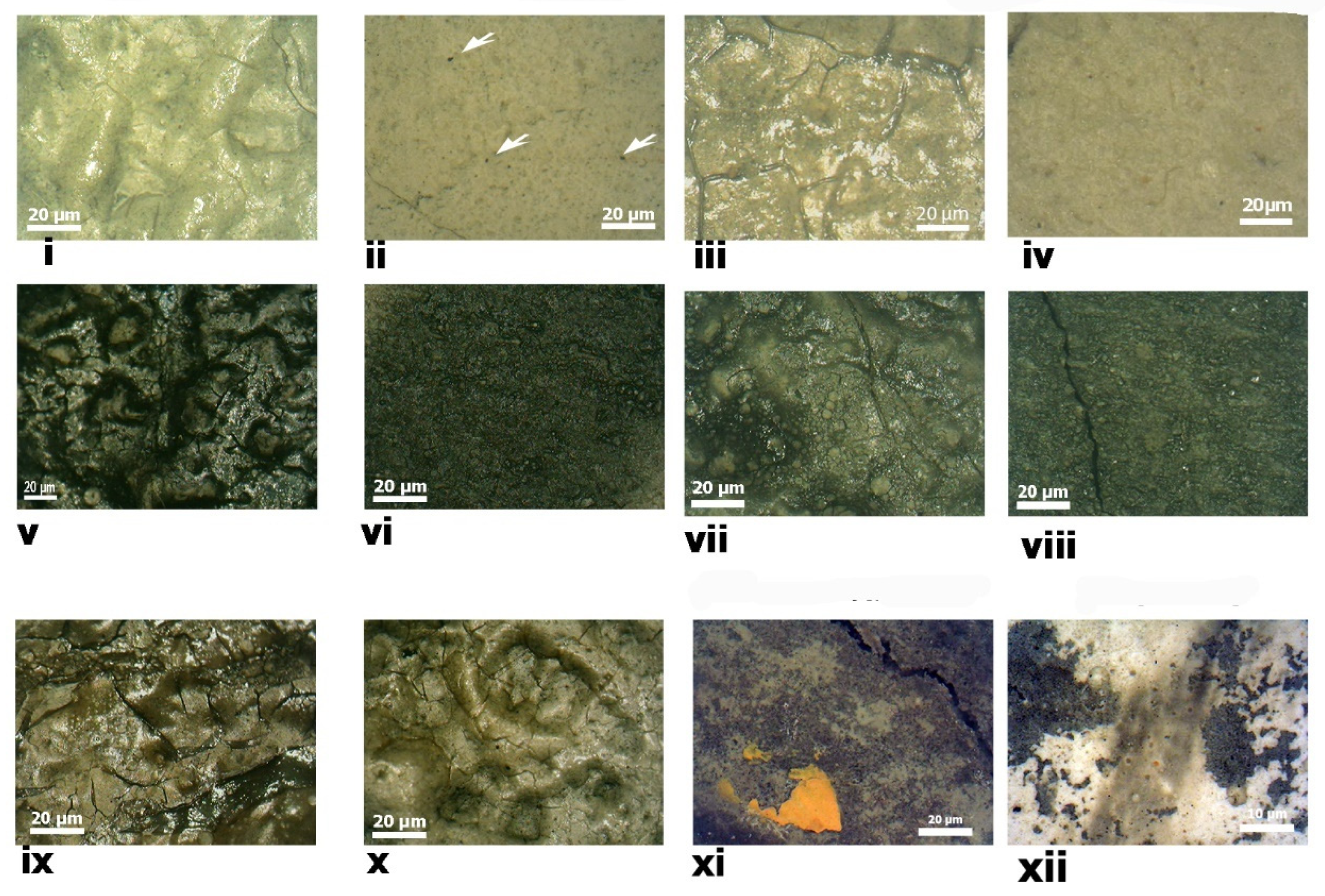
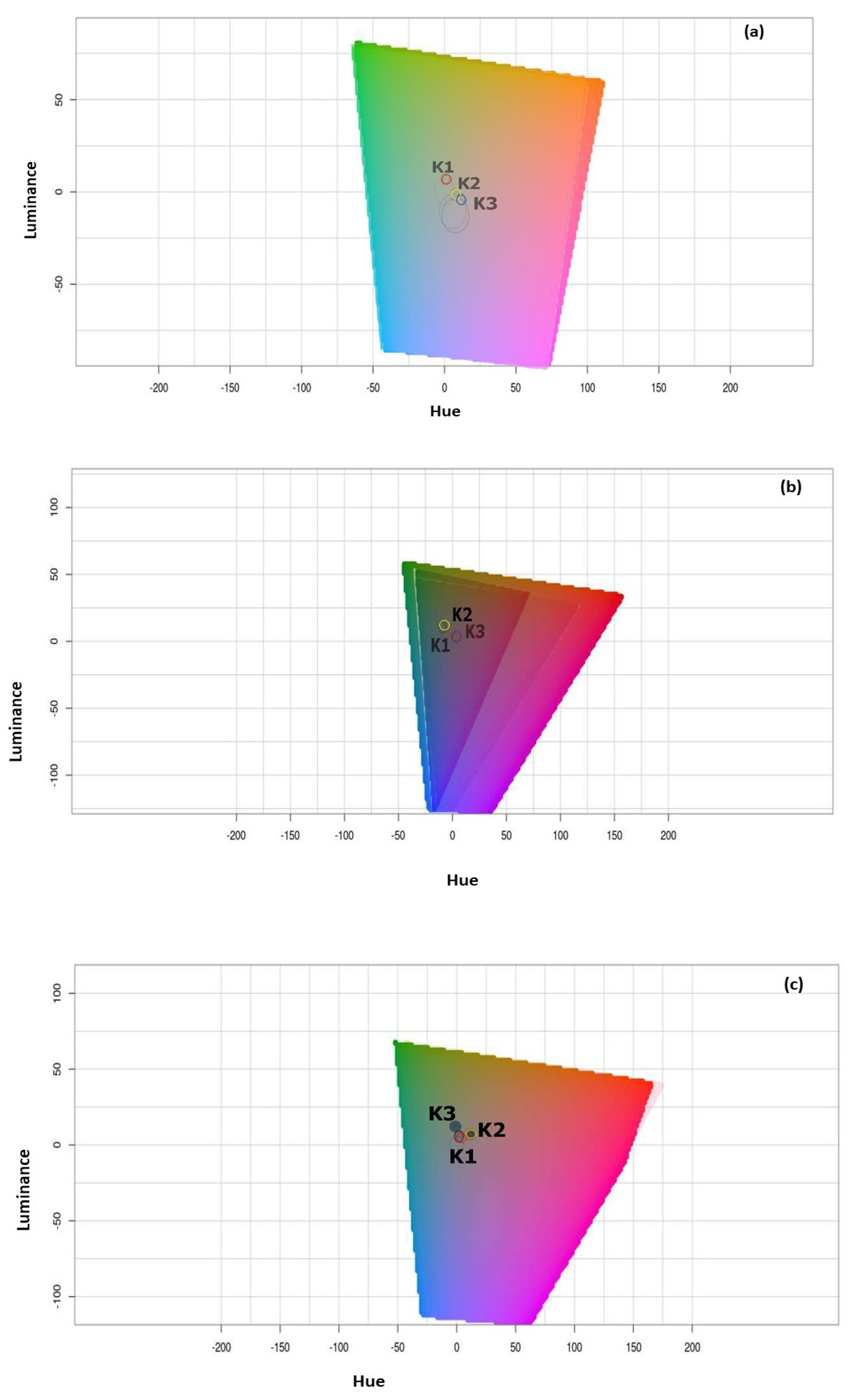
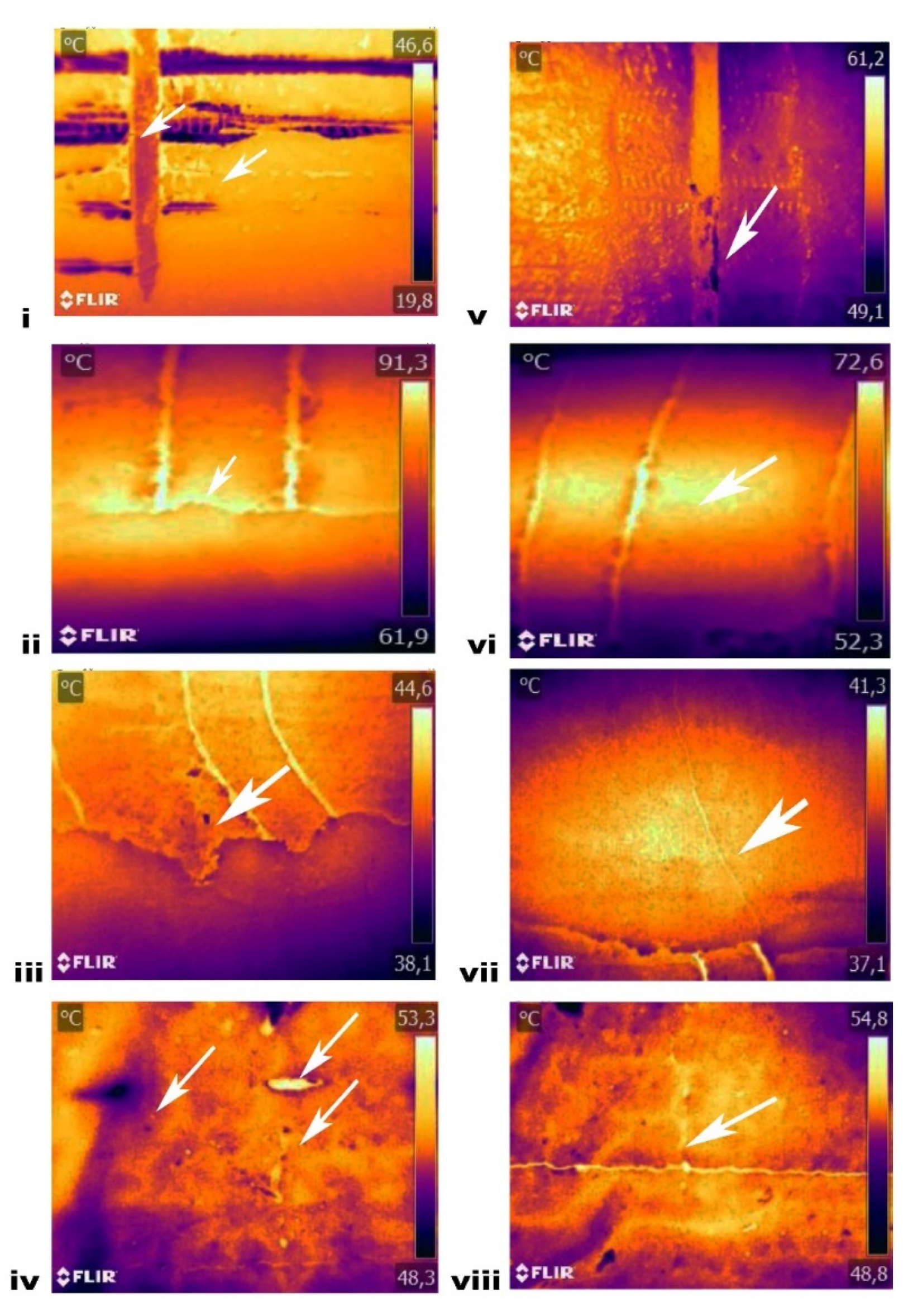
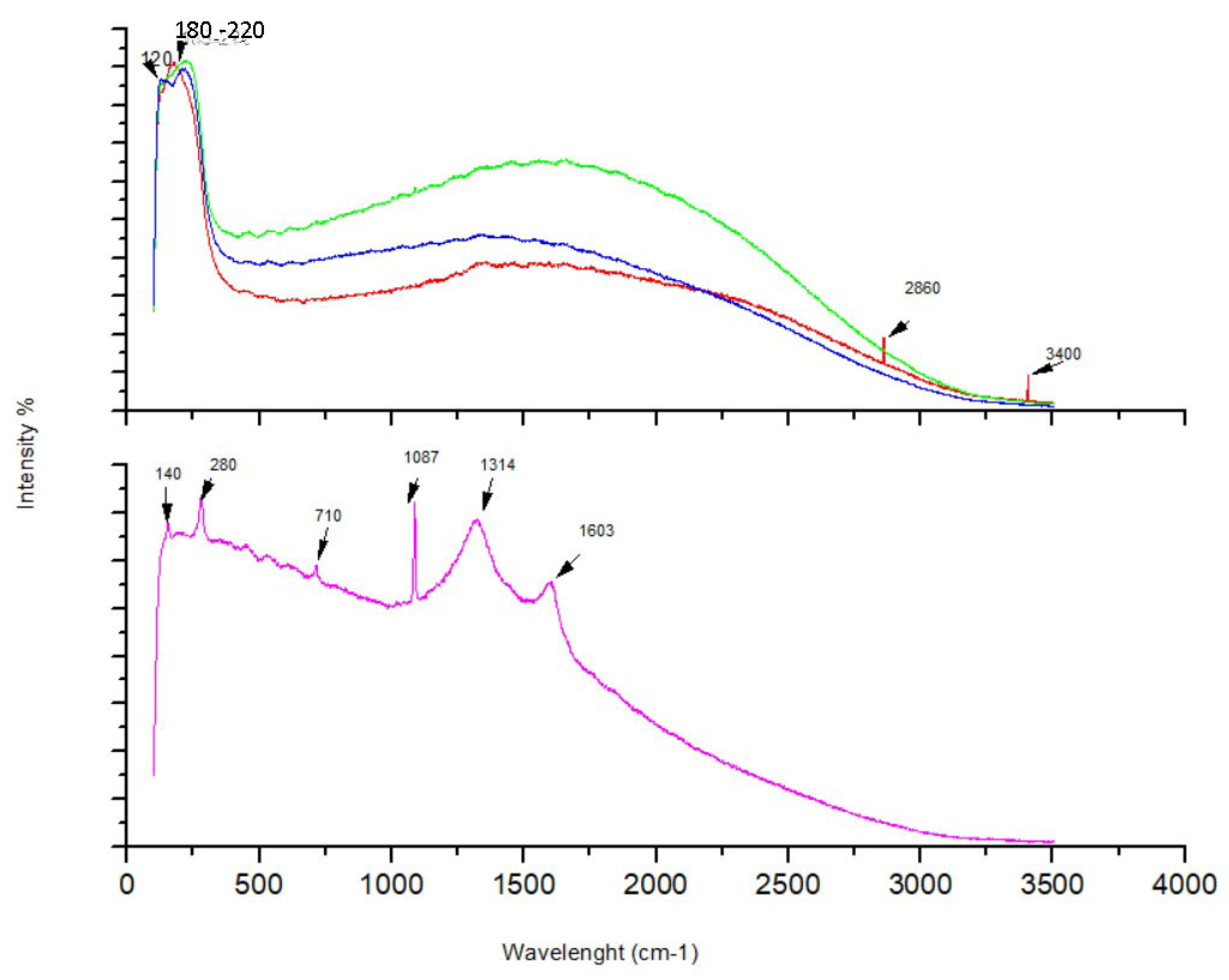
| White | Black | Grey | |||||||
|---|---|---|---|---|---|---|---|---|---|
| Κ1 | K2 | K3 | K1 | K2 | K3 | K1 | K2 | K3 | |
| Lmean | 66.4 ± 2.16 | 71.5 ± 2.95 | 71.8 ± 3.91 | 31.9 ± 2.34 | 36.5 ± 5.8 | 48.1 ± 4.22 | 54.7 ± 6.37 | 53.9 ± 4.37 | 53.4 ± 1.97 |
| a* mean | 0.58 ± 0.37 | 0.21 ± 0.13 | 0.81 ± 0.5 | −0.20 ± 0.18 | −0.35 ± 0.36 | 0.20 ± 0.31 | 1.31 ± 0.38 | −0.18 ± 0.21 | 3.01 ± 0.15 |
| b* mean | 7.36 ± 0.73 | 8.79 ± 0.72 | 9.30 ± 0.87 | 0.76 ± 1.71 | 1.99 ± −1.87 | 5.48 ± 1.43 | 5.98 ± 2.51 | 5.56 ± 1.26 | 5.92 ± 0.65 |
| C* mean | 7.43 ± 0.82 | 8.80 ± 0.72 | 9.34 ± 0.98 | 1.23 ± 1.49 | 1.69 ± −0.85 | 5.34 ± 1.39 | 6.20 ± 2.43 | 5.58 ± 1.26 | 5.93 ± 0.64 |
| H* mean | 82.9 ± 8.97 | 82.7 ± 0.65 | 66.0 ± 2.41 | −12.9 ± 56.53 | −52.2 ± 50 | 42.1 ± 20.41 | 72.3 ± 15.8 | 51.1 ± 8.71 | 74.1 ± 13.89 |
| Brown | Yellow-Brown | ||
|---|---|---|---|
| K1 | K2 | K2 | |
| Lmean | 33.57 ± 3.18 | 41.21 ± 5.66 | 68.25 ± 4.88 |
| a* mean | 2.35 ± 2.21 | −0.12 ± 0.73 | −0.05 ± 0.36 |
| b* mean | 7.04 ± 3.07 | 3.75 ± 2.35 | 6.34 ± 1.15 |
| C* mean | 7.47 ± 3.17 | 3.42 ± 6.05 | 11.41 ± 2.59 |
| Hue | 57.66 ± 37.79 | −36.52 ± 72.24 | −59.27 ± 45.99 |
Disclaimer/Publisher’s Note: The statements, opinions and data contained in all publications are solely those of the individual author(s) and contributor(s) and not of MDPI and/or the editor(s). MDPI and/or the editor(s) disclaim responsibility for any injury to people or property resulting from any ideas, methods, instructions or products referred to in the content. |
© 2023 by the authors. Licensee MDPI, Basel, Switzerland. This article is an open access article distributed under the terms and conditions of the Creative Commons Attribution (CC BY) license (https://creativecommons.org/licenses/by/4.0/).
Share and Cite
Stamatopoulou, E.; Karoglou, M.; Bakolas, A. Integration of NDT to Assess Composite Contemporary Artworks Made on Photosensitized Cement. Heritage 2023, 6, 7261-7276. https://doi.org/10.3390/heritage6120381
Stamatopoulou E, Karoglou M, Bakolas A. Integration of NDT to Assess Composite Contemporary Artworks Made on Photosensitized Cement. Heritage. 2023; 6(12):7261-7276. https://doi.org/10.3390/heritage6120381
Chicago/Turabian StyleStamatopoulou, Eugenia, Maria Karoglou, and Asterios Bakolas. 2023. "Integration of NDT to Assess Composite Contemporary Artworks Made on Photosensitized Cement" Heritage 6, no. 12: 7261-7276. https://doi.org/10.3390/heritage6120381
APA StyleStamatopoulou, E., Karoglou, M., & Bakolas, A. (2023). Integration of NDT to Assess Composite Contemporary Artworks Made on Photosensitized Cement. Heritage, 6(12), 7261-7276. https://doi.org/10.3390/heritage6120381







